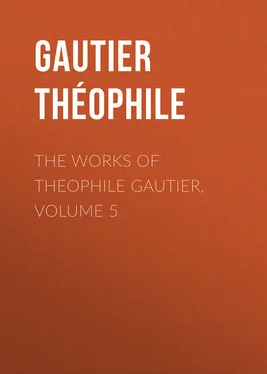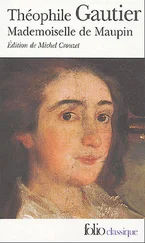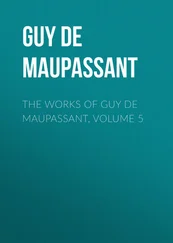Théophile Gautier - The Works of Theophile Gautier, Volume 5
Здесь есть возможность читать онлайн «Théophile Gautier - The Works of Theophile Gautier, Volume 5» — ознакомительный отрывок электронной книги совершенно бесплатно, а после прочтения отрывка купить полную версию. В некоторых случаях можно слушать аудио, скачать через торрент в формате fb2 и присутствует краткое содержание. Жанр: foreign_antique, foreign_prose, на английском языке. Описание произведения, (предисловие) а так же отзывы посетителей доступны на портале библиотеки ЛибКат.
- Название:The Works of Theophile Gautier, Volume 5
- Автор:
- Жанр:
- Год:неизвестен
- ISBN:нет данных
- Рейтинг книги:3 / 5. Голосов: 1
-
Избранное:Добавить в избранное
- Отзывы:
-
Ваша оценка:
- 60
- 1
- 2
- 3
- 4
- 5
The Works of Theophile Gautier, Volume 5: краткое содержание, описание и аннотация
Предлагаем к чтению аннотацию, описание, краткое содержание или предисловие (зависит от того, что написал сам автор книги «The Works of Theophile Gautier, Volume 5»). Если вы не нашли необходимую информацию о книге — напишите в комментариях, мы постараемся отыскать её.
The Works of Theophile Gautier, Volume 5 — читать онлайн ознакомительный отрывок
Ниже представлен текст книги, разбитый по страницам. Система сохранения места последней прочитанной страницы, позволяет с удобством читать онлайн бесплатно книгу «The Works of Theophile Gautier, Volume 5», без необходимости каждый раз заново искать на чём Вы остановились. Поставьте закладку, и сможете в любой момент перейти на страницу, на которой закончили чтение.
Интервал:
Закладка:
A few slaves of the Nahasi race, black complexioned, monkey-faced, with bestial gait, alone braving the heat of the day, were bearing to their masters' homes the water drawn from the Nile in jars that were hung from a stick placed on their shoulder. Although they wore nothing but striped drawers wrinkling on their hips, their torsos, brilliant and polished like basalt, streamed with perspiration as they quickened their pace lest they should scorch the thick soles of their feet on the pavements, which were as hot as the floor of a vapour bath. The boatmen were asleep in the cabins of their boats moored to the brick wall of the river quay, sure that no one would waken them to cross to the other bank, where lay the Memnonia quarter. In the highest heaven wheeled vultures, whose shrill call, that at any other time would have been lost in the rumour of the city, could be plainly heard in the general silence. On the cornices of the monuments two or three ibises, one leg drawn up under their body, their long bill resting on their breast, seemed to be meditating deeply, and stood out against the calcined, whitish blue which formed the background.
And yet all did not sleep. From the walls of a great palace whose entablature, adorned with palmettoes, made a long, straight line against the flaming sky, there came a faint murmur of music. These bursts of harmony spread now and then through the diaphanous shimmer of the atmosphere, and the eye might almost have followed their sonorous undulations. Deadened by the thickness of the walls, the music was strangely sweet. It was a song voluptuously sad, wearily languorous, expressing bodily fatigue and the discouragement of passion. It was full of the eternal weariness of the luminous azure, of the indescribable helplessness of hot countries. As the slave passed by the wall, forgetting the master's lash he would suspend his walk and stop to breathe in that song, impregnated with all the secret homesickness of the soul, which made him think of his far distant country, of his lost love, and of the insurmountable obstacles of fate. Whence came that song, that sigh softly breathed in the silence of the city? What restless soul was awake when all around was asleep?
The straight lines and the monumental appearance of the façade of the palace, which looked upon the face of the square, were typical of the civil and religious architecture of Egypt. The dwelling could belong to a princely or a priestly family only. So much was readily seen from the materials of which it was built, the careful construction, and the richness of the ornamentation.
In the centre of the façade rose a great building flanked by two wings surmounted by a roof in the form of a truncated triangle. A broad, deeply cut moulding of striking profile ended the wall, in which was visible no opening other than a door placed, not symmetrically in the centre, but in the corner of the building, no doubt to allow ample space for the staircase within. A cornice in the same style as the entablature surmounted this single door. The building projected from a wall on which rested like balconies two stories of galleries, resembling open porticoes, composed of pillars singularly fantastic in style. The bases of these pillars represented huge lotus-buds, from the capsule of which, as it opened its dentelated rim, sprang the shaft like a giant pistil, swelling below, more slender at the top, girdled under the capital by a collar of mouldings, and ending in a half-blown flower. Between the broad bays were small windows with their sashes in two parts filled with stained glass. Above ran a terraced roof flagged with huge slabs of stone.
On the outer galleries great clay vases, rubbed inside with bitter almonds and closed with leaves, resting upon wooden pedestals, cooled the Nile water in the draughts of air. Tables bore pyramids of fruits, sheaves of flowers and drinking-cups of different shapes; for the Egyptians love to eat in the open air, and take their meals, so to speak, upon the public street. On either side of the main building stretched others rising to the height of one story only, formed of a row of pillars engaged half-way up in a wall divided into panels in such a manner as to form around the house a shelter closed to the sun and the gaze of the outer world. All these buildings, enlivened by ornamental paintings, – for the capitals, the shafts, the cornices, and the panels were coloured, – produced a delightful and superb effect.
The door opened into a vast court surrounded by a quadrilateral portico supported by pillars, the capitals of which showed on each face a woman's head, with the ears of a cow, long, narrow eyes, slightly flattened noses, and a broad smile; each wore a thick red cushion and supported a cap of hard sandstone. Under the portico opened the doors of the apartments, into which the light came softened by the shade of the galleries. In the centre of the court sparkled in the sunshine a pool of water, edged with a margin of Syêné granite. On the surface of the pond spread the heart-shaped leaves of the lotus, the rose and blue flowers of which were half closed as if overcome by the heat in spite of the water in which they were plunged. In the flower-beds around the pool were planted flowers arranged fanlike upon small hillocks, and along the narrow walks laid out between the beds walked carefully two tame storks, which from time to time snapped their bills and fluttered their wings as if about to take flight. At the angles of the court the twisted trunks of four huge persæas exhibited a mass of metallic green foliage. At the end a sort of pylon broke the portico, and its large bay, framing in the blue air, showed at the end of a long avenue a summer kiosk of rich and elegant design. In the compartments traced on the right and on the left of the arbour by dwarf trees cut into the shape of cones, bloomed pomegranates, sycamores, tamarinds, periplocas, mimosas, and acacias, the flowers of which shone like coloured lights on the deep green of the foliage which overhung the walls.
The faint, sweet music of which we have spoken proceeded from one of the rooms which opened into the interior portico. Although the sun shone full into the court, the ground of which blazed in the flood of light, a blue, cool shadow, transparently intense, filled the apartment, in which the eye, blinded by the dazzling reverberation, sought to distinguish shapes and at last made them out when it had become accustomed to the semi-light. A tender lilac tone overspread the walls of the room, around which ran a cornice painted in brilliant tones and enriched with small golden palm-branches. Architectural designs skilfully combined formed on the plain spaces panels which framed in ornaments, sheaves of flowers, birds, diapers of contrasted colours, and scenes of domestic life.
At the back, near the wall, stood a strangely shaped bed, representing an ox wearing ostrich-feathers with a disc between its horns, broadening its back to receive the sleeper upon a thin red mattress, and stiffening by way of feet its black legs ending in green hoofs, while its curled-up tail was divided into two tufts. This quadruped bed, this piece of animal furniture, would have seemed strange in any other country than Egypt, where lions and jackals are also turned into beds by the fancy of the workmen.
In front of the couch was placed a stool with four steps, which gave access to it: at the head, a pillow of Oriental alabaster, destined to support the neck without deranging the head-dress, was hollowed out in the shape of a half moon. In the centre a table of precious wood carved with exceeding care, stood upon a richly carved pedestal. A number of objects were placed upon it: a pot of lotus flowers, a mirror of polished bronze on an ivory stand, a vase of moss agate filled with antimony powder, a perfume spatula of sycamore wood in the shape of a woman bare to the waist stretching out as if she were swimming, and appearing to attempt to hold her box above the water.
Читать дальшеИнтервал:
Закладка:
Похожие книги на «The Works of Theophile Gautier, Volume 5»
Представляем Вашему вниманию похожие книги на «The Works of Theophile Gautier, Volume 5» списком для выбора. Мы отобрали схожую по названию и смыслу литературу в надежде предоставить читателям больше вариантов отыскать новые, интересные, ещё непрочитанные произведения.
Обсуждение, отзывы о книге «The Works of Theophile Gautier, Volume 5» и просто собственные мнения читателей. Оставьте ваши комментарии, напишите, что Вы думаете о произведении, его смысле или главных героях. Укажите что конкретно понравилось, а что нет, и почему Вы так считаете.












